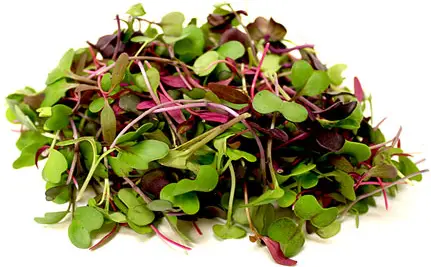These days, if you live a busy and active life, it can be difficult to make sure you’re eating right and getting your essential doses of vitamins and nutrients. Nutrition supplements can be quite costly, and they often have questionable ingredient lists. Incorporating nutritious microgreens (not to be confused with sprouts) into a variety of dishes is a healthy, natural way to get the fresh vegetables you need to increase nutrient intake and add a splash of color. They’re also packed with flavors, easy to grow as well as an easy way to get started with gardening!
Almost any type of vegetable or herb can be turned into these tiny greens, which make them a very versatile addition to your diet. Because microgreens typically grow in the soil like large vegetable counterparts, they are less prone to spreading water-borne bacteria such as E.Coli which sprouts are notorious for. Before recently, commercially grown microgreens were only available to foodservice professionals, who used microgreens as flavor accents and garnishes on salads, soups, and sandwiches.
We’ll discuss some sorts of benefits of microgreens in this article. If you’re interested in how to choose or grow them or finding out more about the many options available or the many ways to eat them, check out our other posts.
What Makes Fresh Microgreens Healthy?
There are a few features that result in the designation of homegrown microgreens as a ‘superfood’.
First, they contain a highly concentrated amount of vitamins, minerals, beneficial plant compounds, and antioxidants which makes them nutrient dense. Compared to mature plants or full-grown plants, microgreens have up to 40x more nutrient content and a greater variety of antioxidants according to studies. As an example, red cabbage microgreens have 40 times the vitamin E, 6 times the vitamin C, and 69 times the vitamin K compared to mature red cabbage.
Secondly, they can be eaten raw (with an intense flavor) which helps them maintain their nutrient levels, as the heat in cooking can destroy enzymes, vitamins, and phytonutrients.
Finally, when they’re homegrown, they’re fresh! Once harvested weeks after germination, any plant starts losing nutritional content. Spinach, for instance, is packed with vitamins and can lose 90 percent of its Vitamin C by the time it’s harvested. So, by harvesting mere moments before eating, you get nutrients that the whole living plant has.

What Can You Get From Microgreens?
Every microgreen variety provided a set of nutrients and vitamins, but microgreens in general are an excellent source of useful vitamins, minerals, essential amino acids, and high levels of antioxidants like beta carotene. Your body uses these raw materials from the inside to perform hundreds of actions every day – from making your skin glowing to healing wounds and strengthening your bones. Often you’ll find them described as “high in fiber” and that’s technically true on a percentage basis, but the fiber is really about the total volume, so you’re better off with regular vegetables.
Vitamins are natural substances that a plant or an animal produces. Microgreens are rich sources of vitamin C, vitamin E, and carotenoids. Daikon radish microgreens, pea tendrils, and garnet amaranth are high in vitamin C but also contain large quantities of vitamins and nutrients in general.
Minerals are originally taken in from the earth and water and are stored in the seed and tissues of plants. Minerals that various types of microgreens tend to have a high concentration of include potassium, iron, zinc, magnesium, and copper.
A high antioxidant content helps protect cells along the DNA strand from DNA damage, chronic diseases, and cell death. A variety of polyphenols are abundant in varieties of microgreens like Red Russian Kale which can reduce the risk of heart disease, several types of cancer, and a range of diseases. Mustard microgreens contain large amounts of antioxidants, are rich in fiber, and can help detoxify the liver and blood. The content of carotenoids, another type of antioxidant, was found to be about 5 times higher in microgreens compared to leafy vegetables.
The Bottomline
Microgreens have a higher dose of nutrients than leafy greens, which means they’re typically more concentrated sources of vitamins and minerals. Including just a few servings of microgreens in your diet along with plenty of other fruits and vegetables can ensure you are getting the key nutrients you need to maintain a healthy lifestyle and decrease disease risk factors.
For people who follow a vegan, vegetarian, or raw food diet, as well as for people who cannot consume fresh vegetables or fresh greens due to issues of availability, cost, or health, tailored microgreens may also be beneficial. You can use these polyphenol-rich microgreens with an aromatic flavor in just about any recipe that you might use regular greens in.

